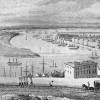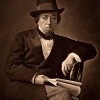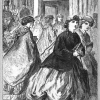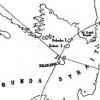
Rebecca Nesvet, “Miss Whitehead, ‘The Bank Nun’”
An urban legend maintains that early in the nineteenth century, one Miss Whitehead, colloquially known as “the Bank Nun,” frequently visited the Bank of England to accuse that institution of destroying her brother, a financial forger. This essay traces the evolution of this legend. I contend that in 1837, an obscure comic sketch reacted to that year’s major financial crisis by dredging up the Romantic-era case of financial forger Paul Whitehead and focusing on his surviving sister. Displacing her brother’s notoriety onto her, the sketch reinvents her as “the Bank Nun,” a grotesque magnet for lingering Romantic-era anxieties about the circulation of paper credit, financial forgery, and women. A succession of plagiarisms, retellings, and reappraisals of this ephemeral sketch and its portrait illustration made the Bank Nun a folk heroine of enduring resonance. Via this iconic figure, Romantic-era economic controversy haunts London today.

Anna Vaninskaya, “Russian Nihilists and the Prehistory of Spy Fiction”
Although the rise of modern British spy fiction is usually dated to the Edwardian period, with the names of Kipling, Conrad and Buchan among the first to be mentioned, the genre owes its existence to a little-noted precursor in late Victorian popular literature: the Russian Nihilist romance. Many of the ideological and formal aspects of the genre can be traced back to the tales of police espionage, terrorist revolutionaries, and double agents that titillated audiences in the last decades of the nineteenth century. In the 1880s and 90s, the age-old literary figure of the spy underwent a number of transformations that would establish its new meanings for the new century.

Carolyn W. de la L. Oulton, “‘Coquetting amid incredible landscapes’: Women on the River and the Railway”
The opening of the first direct railway line from London to the Kent coast in 1862 challenged traditional dichotomies between town and country, and contributed to a growing nostalgia associated with the river. Fin-de-siècle writers used the apparent opposition between rail and river, city and country, to ask new questions about the place of women in a rapidly changing world; the transition to a new century further strained the traditional dichotomy between feminised pastoral and masculinised industrial, a tension reflected in the problematic portrayal of rail and water in the work of E. Nesbit.

Robert O’Kell, “On Young England”
Young England was a short-lived social and political movement that developed from the altruistic ideas of a small parliamentary ginger group within the Conservative Party in the 1840s. At the core of the movement were Benjamin Disraeli (their acknowledged leader), Lord John Manners, George Sydney Smythe and Alexander Baillie Cochrane, all of whom were appalled at the state of party politics, class conflict, and the economic and moral condition of Victorian England’s poor. Their dissatisfaction with Sir Robert Peel’s leadership of the Party gained popular momentum when, between 1844 and 1847, Disraeli published a trilogy of novels that embodied both devastating satirical attacks on traditional Tory politics and an idealistic, nostalgic vision of a revitalized aristocracy motivated by social duty.

Anna Kornbluh, “Thomas Hardy’s ‘End of Prose,’ 1896”
This entry considers Thomas Hardy’s “End of Prose,” his renunciation of the novel in favor of poetry, as an important event in nineteenth-century literary history, motivated by aesthetic concerns. It reads the geometric imagery in Hardy’s final novel, Jude the Obscure, in connection with the advent of non-Euclidean geometry, suggesting that mathematical forms inspired Hardy’s turn to the poetic line.

Dianne F. Sadoff, “The Silver Fork Novel, 1824-41”
Between 1824, when Theodore Hook’s sketches, Sayings and Doings, were published as a volume, and 1841, when Catherine Gore’s Cecil, a Peer, appeared, the silver fork novel was among the most popular fictional modes. This sub-genre rewrote Jane Austen’s narratives for a more exclusive class and a new, reform-minded middling reader with class aspirations, thus preparing for the mid-century emergence of William Makepeace Thackeray’s and Charles Dickens’s novels.

Richard Menke, “The End of the Three-Volume Novel System, 27 June 1894”
In 1894, the great private circulating libraries announced that they were changing their terms for purchasing fiction, ultimately leading publishers to abandon the long-standard three-volume format for novels. This essay considers the three-volume novel system as part of an information empire and examines the collapse of that system both through the work of book historians and through the writing of Oscar Wilde, George Gissing, Ella Hepworth Dixon, Rudyard Kipling, and other writers of the 1890s.

Monique R. Morgan, “The Eruption of Krakatoa (also known as Krakatau) in 1883”
This essay gives a brief overview of the events of 26-27 August 1883, when the volcanic island of Krakatoa in Indonesia exploded; it generated tsunamis which killed over 36,000 people, was heard 3,000 miles away, and produced measurable changes in sea level and air pressure across the world. The essay then discusses the findings of the Royal Society’s Report on Krakatoa, and the reports in the periodical press of lurid sunsets resulting from Krakatoa’s dust moving through the atmosphere. It closes by examining literature inspired by Krakatoa, including a letter by Gerard Manley Hopkins, a poem by Alfred Tennyson, and novels by R. M. Ballantyne and M. P. Shiel.

Jonathan Farina, “On David Masson’s British Novelists and their Styles (1859) and the Establishment of Novels as an Object of Academic Study”
This essay shows how the publication of David Masson’s British Novelists and their Styles, the first monograph on fiction by a professor of English literature, institutionalized the study of fiction by representing novels as material evidence of otherwise ephemeral, ideological, unconscious, or otherwise invisible “currents” of history. Other Victorian theories of fiction were more manifestly influential in establishing the formalist modes of fictional analysis and narratology that have since dominated the discipline, but Masson’s work nevertheless exhibits investments in feminism, cosmopolitanism, liberalism, statistics, ideology, and history that uncannily anticipate the interests of modern scholars of Victorian fiction. However generically unfamiliar it might look, then, Masson’s work marks the emergence of the cultural interests, disciplinary objectives, and other conditions of representation that underwrite academic criticism as we now know it.
